Common Houseplant Pests: Types, Identification, and Getting Rid of Houseplant Bugs
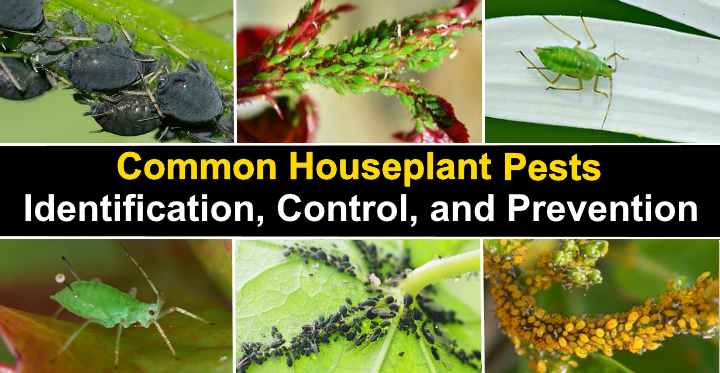
Houseplant pests can multiply quickly indoors and infest many of your prized plants. The growing conditions indoors—warmth, moisture and light—can provide the perfect environment for houseplant bugs to thrive. Knowing how to identify common indoor plant pests is key to getting rid of the bugs quickly. It is also essential to regularly monitor houseplants for signs of plant pests to prevent infestations from getting out of hand.
Caring well for indoor plants can help prevent them from being susceptible to common pests. Researchers say that houseplant bugs easily affect stressed plants. The result is weak growth, changes in leaf color, spots or speckles on stems and leaves, webbing under leaves, or wilting. Because getting rid of indoor plant pests is challenging, pest prevention is crucial when caring for houseplants. (1)
In this article, you will learn how to identify the most common pests and bugs that affect houseplants. Along with descriptions of the pesky insects, images and their scientific names will help with identification. You will also find out natural methods of getting rid of bugs in houseplants.
When you find bugs on houseplants, always remember to isolate the plant from your other indoor plants immediately. Doing so will help you get rid of the indoor plant pests effectively and prevent further infestations.
Types of Houseplant Pests
There are many types of houseplant bugs, such as tiny aphids that can be yellow, brown, red, green, white, or black color. Mealybugs are pests that look like small bits of white fluff stuck to plant stems and leaves. Thrips are long creatures with pointed tails and can be green, black, or brown color. Although difficult to spot, microscopic spider mites are houseplant pests that can leave fuzzy webs on leaves or stems.
The most common houseplant pests that you can find on the plant’s leaves or in the soil are fungus gnats. These soil dwelling pests look like small dark flies similar to fruit flies and their larvae could damage roots. Common pests that live on indoor plant leaves include aphids, whitefly, spider mites, thrips, mealybugs, and scale.
Houseplant Bugs and Pests (With Images)
Now that you know what the most common houseplant pests are, let’s find out more about them. Identifying the type of bugs or pests on your indoor plants will help you control them before they do permanent damage.
Aphids

Aphids are plant pests that can look like tiny green bugs but can also have red, yellow, black or white color
Aphids are pests that suck the sap of houseplants and can damage indoor plants so much that they die. These common houseplant pests are from the superfamily Aphidoidea and are commonly called greenfly or blackfly.
Outdoors, predatory insects such as wasps, ladybugs, and larvae help control aphid populations. However, indoor aphids in houseplants rapidly reproduce as they have no predators.
How to identify aphids on houseplants
Aphids are tiny pests that only measure 1/8” (3 mm) long. They are commonly a green color, which makes them hard to spot on plants. But these tiny plump insects can be almost any color—black, yellow, red, brown, or blue. There are even fluffy white woolly aphids that are sap-sucking plant pests.
If you have an aphid houseplant infestation, you may see clusters of these minuscule fat insects on young stems and leaves. You may also notice a sticky substance on leave along with black sooty mold fungus. Leaves may appear to be wilting.
How to get rid of pests from plants indoors
Aphids are notoriously tricky to get rid of from plants. Usually, a good spray of water can dislodge most of the bugs. You should then wash the plant’s leaves and stems with mild soapy water.
To make an aphid-destroying natural spray, mix 1 tsp. of organic mild liquid soap with 33 fl. oz. (1 l) of warm water. Put in a spray bottle and apply daily until the aphids have gone.
Other ways of getting rid of aphids in houseplants include neem oil and rubbing alcohol.
Fungus Gnats (Soil Gnats)
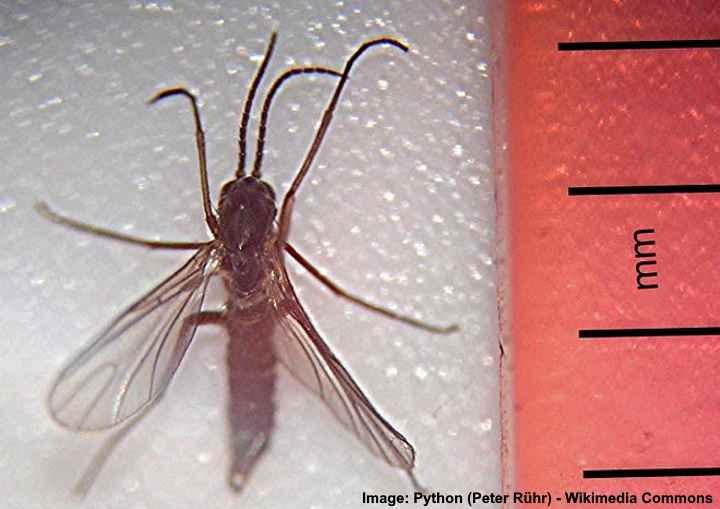
Fungus gnats (soil gnats) are soil dwelling small black houseplant pests that feed on fungus
Fungus gnats are common houseplant bugs that live in and on the soil and feed on fungus. These pesky, small, dark winged insects are from the family Sciaridae and don’t usually affect healthy houseplants. They lay eggs in the soil and their larvae can cause root damage if the infestation is heavy. But usually fungus gnat larvae only eat rotting roots. Over-watering indoor plants can cause fungal infections, which can attract these small black pests.
Fungus gnat identification on plants
Identifying fungus gnats on houseplants is relatively easy as they look like small fruit flies crawling over the soil or flying around your plants. The difference between fungus gnats and fruit flies is that fruit flies are attracted to fruit and garbage, not your beloved houseplants.
Adult fungus gnats measure between 0.08” and 0.3” (2 – 8 mm) long and tend to swarm around plants. These annoying tiny flies rarely harm plants but are a nuisance indoors.
How to get rid of bugs on indoor plants
The best way to get rid of fungus gnats on houseplants is to use Bacillus thuringiensis var. Israelensis—also called Bti or H-14. This is a natural product that targets fungus gnat larvae in the potting soil. According to researchers, this is the only effective natural insecticide against fungus gnats. (2)
To prevent fungus gnats affecting your plants, keep moisture to a minimum in houseplant soil. If necessary, you may have to change the potting soil and sterilize the pot before repotting.
Another way to kill off fungus gnats is by using diatomaceous earth (DE). This natural silica powder kills gnats and other houseplant pests by destroying their outer layer. However, the soil must be dry for DE to work on fungus gnats.
You can also place yellow sticky stakes to catch the tiny flying gnats.
Learn about other effective ways to get rid of fungus gnats on houseplants.
Mealybugs

Mealybugs look like little white fluffy bugs on plants
Mealybugs are another type of sap-sucking insect that can destroy your houseplants. These small white fuzzy creatures belong to the family Pseudococcidae. Mealybugs are pets that suck on plant juices and, if not treated, will suck the sap from plants until they die.
How to identify mealybugs on indoor plants indoors
If you notice small white bugs on your indoor plant that look like dust or bits of cotton wool, the chances are that they are mealybugs. The tiny white pests are about 0.25” (6 mm) long with an oval, segmented body.
The sap-sucking insects live in the joints of leaf stems and the main stem. Another sign of mealybugs is leaf yellowing caused by the plant weakening and starting to die. You may also notice a sticky substance called honeydew and black sooty molds on plant stems.
How to get rid of mealybugs in houseplants
It is essential to get rid of mealybugs on indoor plants at the first sign of an infestation. You can use rubbing alcohol to kill the white bugs on contact. Apply the alcohol daily with a cotton bud and treat the plant. Then continue using until all signs of mealybugs on your plant have gone for good.
Spider Mites

Left picture: spider mites on a lemon plant. Right: red spider mite (enlarged image)
Spider mites are one of the most destructive houseplant pests that can infest your indoor plants. These tiny spider-like pests are in the family Tetranychidae. They are difficult to spot because they only measure 0.04” (1 mm). But they leave behind tell-tale webbing under plant leaves. Spider mites kill plants by feeding on their sap. In time, leaves start to turn yellow and die.
Spider mite identification on house plants
The most common way to identify spider mites is by checking for silky spider webs on your plant. Individual bugs are challenging to spot because they are so tiny. When you notice spider mites crawling around plants, it usually means that the infestation is large.
When buying plants from a garden center, always check for signs of spider webs before buying.
Getting rid of indoor houseplant pests naturally
As soon as you notice signs of spider mite pests on indoor plants, it’s critical to act quickly. Use neem oil to get rid of the sap-sucking mites rapidly.
To make a neem oil spray solution, mix 1.5 tsp. of neem oil and 1 tsp. liquid soap with 33 fl. oz. (1 l) of warm water. Thoroughly wash your plant leaves to get rid of most of the insects. Use the neem oil spray weekly to eradicate spider mites. Even when the spider mites have gone, continue using neem oil every two weeks to spray as a preventative measure.
To prevent spider mites from coming back, keep humidity levels high as they tend to prefer dry, warm conditions.
Whitefly
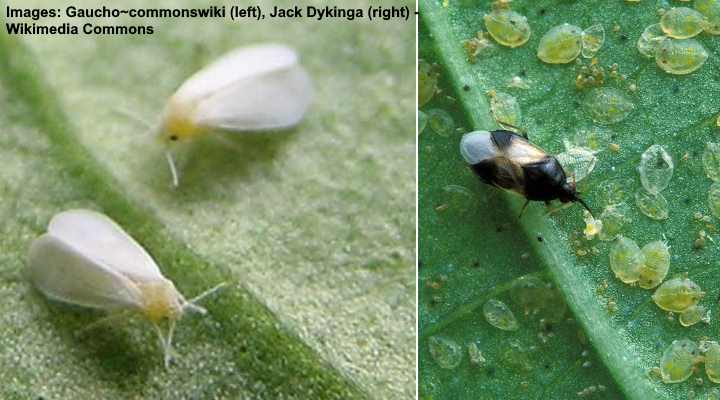
The tiny whitefly is a pest that can usually be found on the underside of the houseplant’s leaves. Right image: A bug feeding on whitefly larvae
As their name suggests, this indoor plant pest is a small white-colored fly, and they can weaken plants if the infestation is large. Whitefly is a winged insect in the family Aleyrodidae. They typically live on the underside of plants and can range in size from microscopic to 0.07” (2 mm) in length. Disturbing an infested plant usually results in a swarm of whitefly emerging from under the leaves. This is one way to tell mealybugs apart from whitefly—mealybugs just crawl as they don’t fly. However, whitefly can damage plants just like mealybugs, aphids, and thrips.
How to identify whitefly infestation on houseplants
To look for signs of whitefly on indoor plants, turn leaves over to identify small whiteflies. As soon as you spot whiteflies, it is critical to get rid of these pests quickly. They reproduce at an alarming rate, and their sap-sucking feeding habits stunt the growth of your indoor plants.
How to get rid of bugs from plants
There are several methods to get rid of these minuscule whiteflies from plants. For example, you can trap them with yellow sticky traps to reduce their numbers.
You can also use the neem oil spray for houseplant pests mentioned in the article. However, because whiteflies fly away when the plant is disturbed, neem oil is only effective on the eggs and larvae. Spray regularly to disrupt the whitefly lifecycle to control these houseplant pests.
If some leaves are heavily infested, trim them off and put them in the outdoors garbage.
Thrips
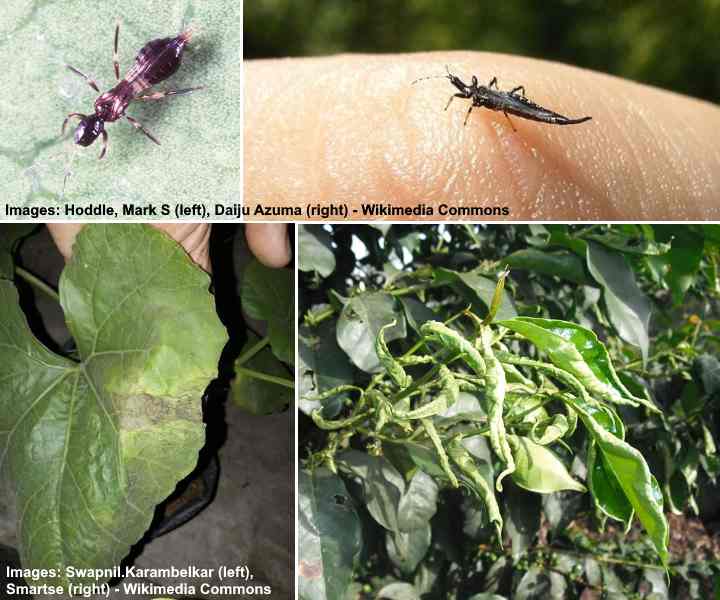
Thrips include many species which are usually black or brown (upper pictures). Lower images: Leaf suffering from thrips (left). Coffee tree leaves rolled up by thrips damage (right)
Thrips are long skinny black or brown bugs that you may find crawling over houseplants. These common indoor plant pests are tiny insects in the order Thysanoptera and are less than 0.04” (1 mm) long. For many indoor plant owners, thrips are one of the most annoying house pests. They crawl and fly and quickly move from plant to plant, causing widespread infestations.
Unlike fungus gnats, thrips are not little bugs that live in the soil. They move across the soil, up the plant stems, and under leaves. They feed on the sap of houseplants and cause stunted growth and discolored leaves.
How to identify thrips on house plants
Thrips are easy to identify because they have long slender black bodies with pointy tails. These long thin pests are usually black, but they can also be brown, greenish-yellow, or white. You will often find them on the underside of leaves. If you see tiny white or yellowish-green specks, they could be baby thrips.
Other signs of a thrip infestation include brown stripes on leaves, leaf drop, or parts of plants start dying.
How to get rid of thrips from plants indoors
It can be challenging to get rid of thrips for good. So, perseverance is the key.
One home remedy for getting rid of thrips is to wash leaves with insecticidal soap. Soap kills the small black bugs on your plant. After thoroughly washing the leaves, rinse off any residue. Remember to test the soap on one leaf to make sure that it won’t damage your plant.
The other way of getting rid of trips on houseplants is to use the neem oil solution. Spray the neem oil solution on plant leaves once a week. Some of the natural insecticide kills thrips on contact, and other thrips die when they consume it.
Scale

Left picture: A cluster of scale insects on a stem. Right image: White waxy scales on cycad leaf
Scale insects are common indoor plant bugs that feed on the sap of plants and can cause a lot of damage. These small brown pests are in the superfamily Coccoidea, and they are usually found on houseplant stems and leaf joints. Scale insects are difficult to identify because they come in various shapes, sizes, and colors.
How to identify scale insect pests on houseplants
It is challenging to spot scale on indoor plants. The small insect pests don’t crawl, scurry, or fly. But instead, they can resemble brown bumps on stems that seem like a small growth. They are usually brown-colored, but they can be any shade from white to reddish-brown.
These houseplant pests are more noticeable when their population grows, and you see clusters of bumps on stems and leaf joints.
How to get rid of pests from indoor plants
To get rid of scale bugs from houseplants, try some rubbing alcohol. Using a cotton bud, apply alcohol to the scale insects to kill them on contact. Check every crevice of the plant because scale pests like to lurk in corners. Also, remove some soil from around the stems to look for signs of scale insects there.
Scale is one of the houseplant bugs that lives in soil. So, if you’ve got scale on your plants, it’s a good idea to repot the infested one in fresh a potting mix. Remember to sterilize the pot if you’re using the same one.
Broad Mites
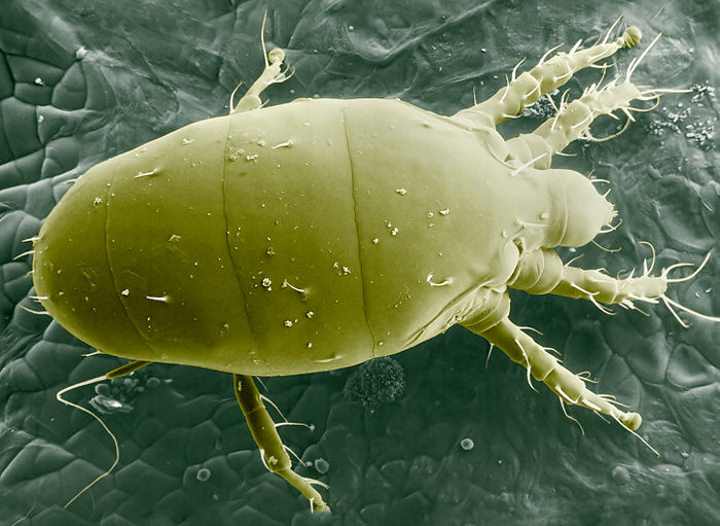
Broad mites are tiny houseplant pests. This image is enlarged
Broad mites are microscopic plant pests that can affect many species of plants, including indoor tropical plants. These tiny-teeny pests are in the insect genus Polyphagotarsonemus, and they live inside plants.
How to identify broad mites
Because broad mites are such tiny pests, they are impossible to see with the naked eye. The signs of a broad mite infestation are curling leaves and stunted growth. These indoor plant pests are tough to get rid of. So, unfortunately, the best way to prevent other plants from getting infected is to get rid of the whole plant.
Springtail
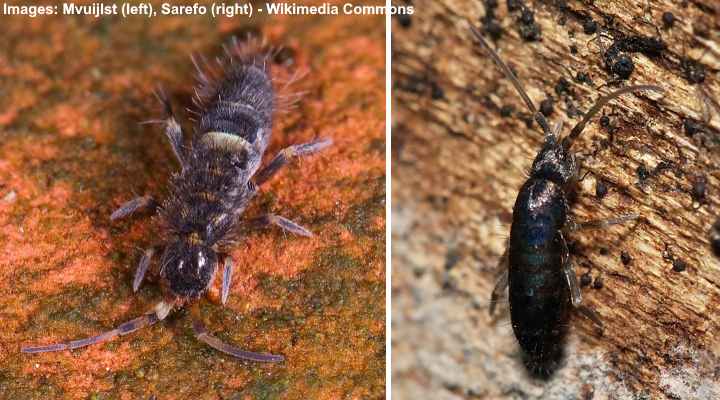
Springtail species are small long bugs that live in the soil
Springtails are a type of long skinny black bug with long antennae that live in the soil of houseplants. Springtails (Collembola) prefer damp soil, and although they can feed on roots, they rarely do any lasting damage to plants.
How to identify springtail
The small insects grow up to 0.24” (6 mm) long and have a segmented body with a fuzzy appearance. The best way to prevent springtails is to avoid soil becoming waterlogged or overly damp. Sprinkle diatomaceous earth over the top of dry potting soil to get rid of these houseplant bugs.
How to Prevent Houseplant Pest Infections
Battling with houseplant pests, aphids, bugs, and spider mites is a time-consuming and frustrating process. The life cycle of many bugs means that adults can die off, but then eggs can hatch, and the problems start over again.
Prevention is key to eliminating all types of indoor plant pests from your home. Here are some helpful tips on preventing common plant pests from infecting your prized houseplants:
- Always check plants you buy in garden centers or stores for signs of pest or bug activity. The most common ones are webbing, tiny flies, unusual spots on leaves, or brown bumps on stems.
- Check the underside of leaves for pests.
- Look for sticky substances on stems that could be a sign of aphids or mealybugs.
- Provide the optimal conditions for healthy plant growth—healthy plants are less prone to pests.
- Use commercially prepared potting soil rather than soil from the garden.
Related articles:
